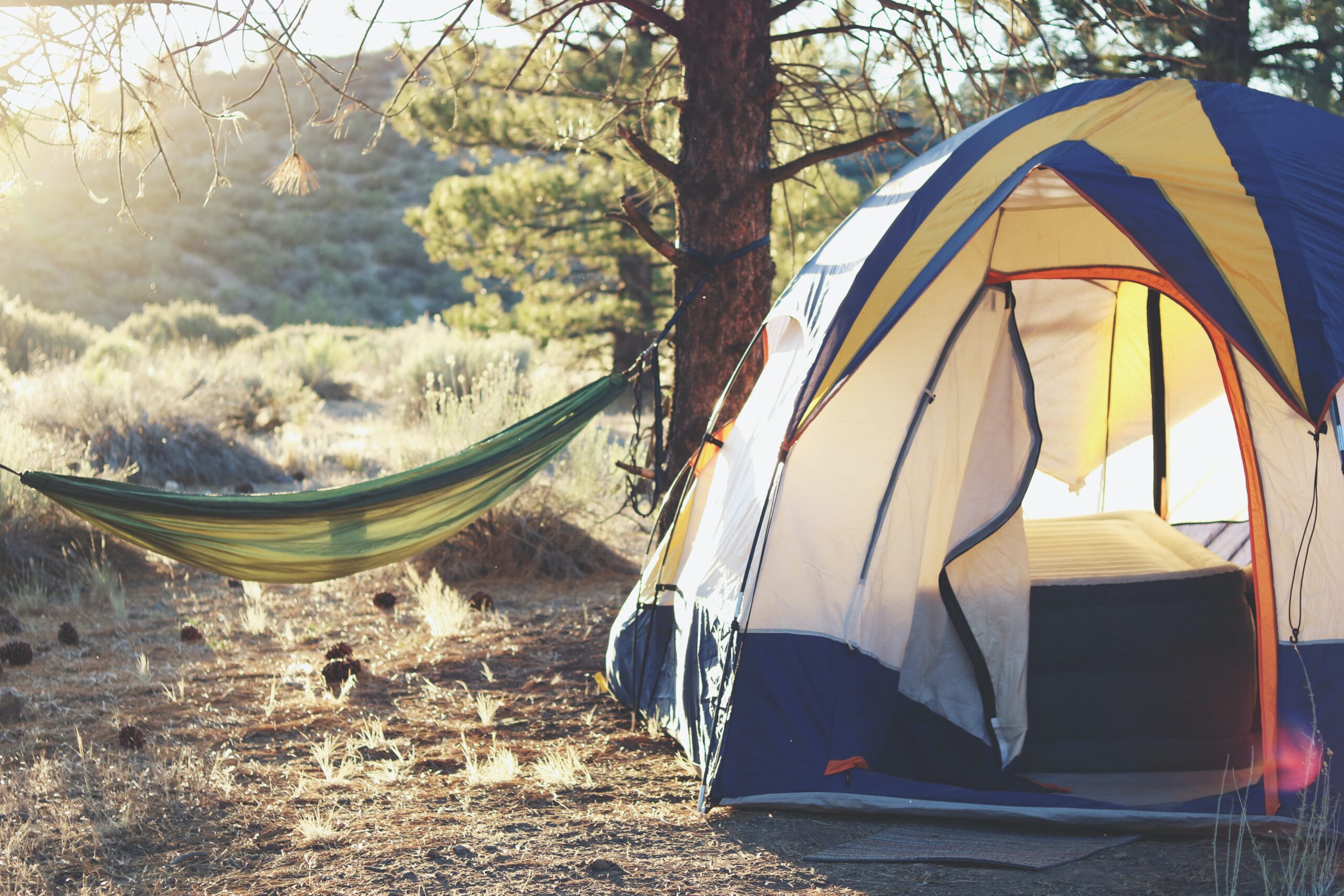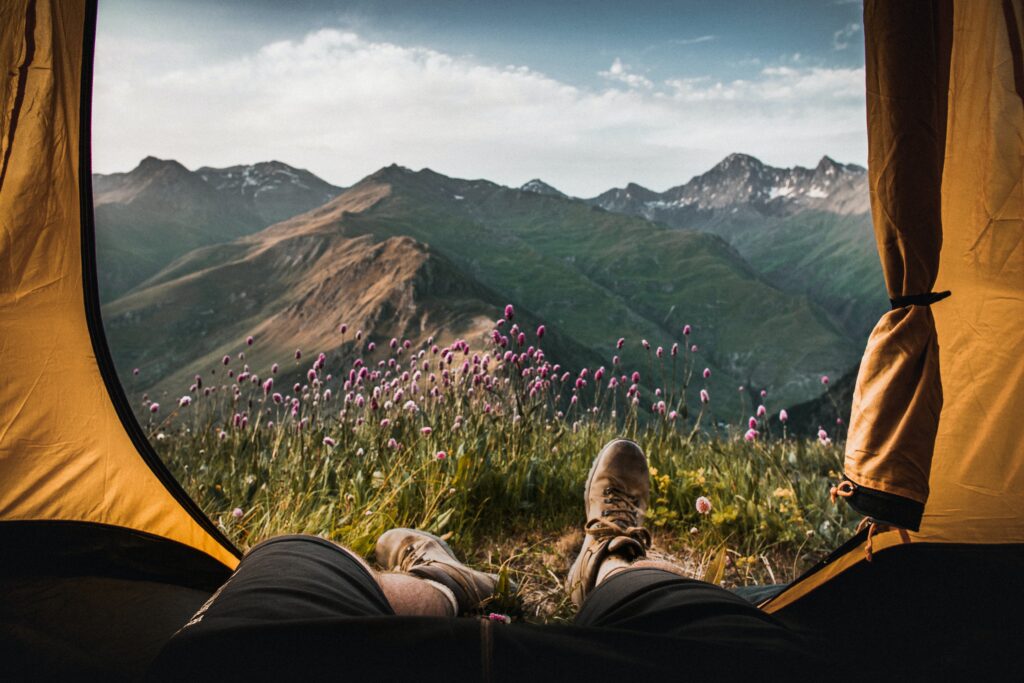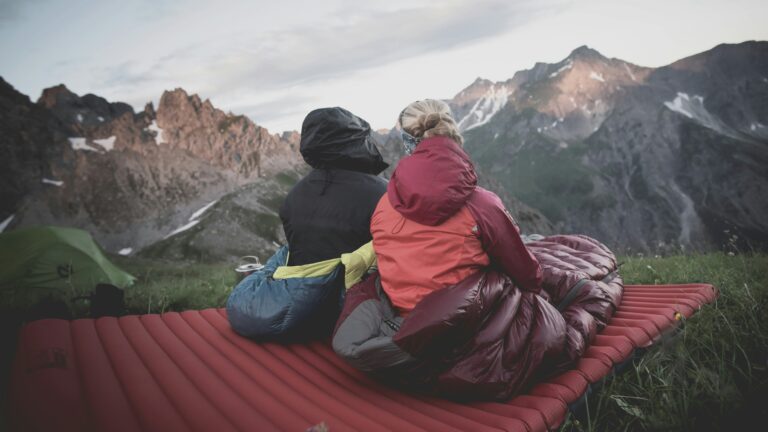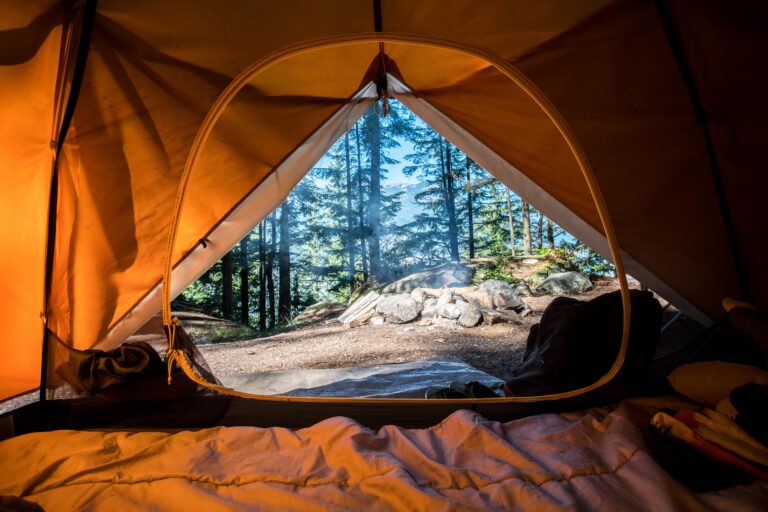Stealth Camping: A Beginner’s Guide for Van or Tent Life in 2025
Have you ever wanted to try stealth camping, but are not sure where to begin? Read this comprehensive guide to find out how to start.

Last Updated on 3 May 2025
Are you ready to embark on a thrilling adventure while saving money on accommodation?
Welcome to the world of stealth camping, where you’ll learn the art of blending in, finding the perfect spot, and living the van or tent life with minimal expenses. This is something we’ve done over the years in the UK and abroad and have thoroughly enjoyed it.
Spending the night undetected in plain sight or more off-grid when we wild camp is an exhilarating experience. Of course, the question of whether it’s legal depends on where and how you do it, but one thing’s for sure: it’s never nice being woken up in the middle of the night and asked to move on.
If you’re thinking of doing some overnight camping where you can stay hidden from other vehicles and human beings, read on as we uncover the secrets of this exciting lifestyle, from legalities and ethics to essential gear and tips for success.
Read more: The 7 Best Family Tents for 2025
Read more: 9 Top Camping Beds for 2025: Perfect Sleep Under the Stars
Key Takeaways
Stealth camping is a form of wild camping that emphasizes discretion and respect for the environment.
It is essential to research local laws, adhere to Leave No Trace principles, and take precautions for safety when engaging in stealth camping.
Popular apps such as iOverlander and Park4Night provide user reviews.
Understanding Stealth Camping

Stealth camping is an alternative form of wild camping that emphasises remaining undetected, usually for one night, and leaving no trace.
While wild camping is often driven by practical considerations, stealth camping is all about discreetly spending the night in urban or rural areas without drawing attention or paying for a campsite. This unique approach to van or tent life offers adventurers the opportunity to explore cities and wild places alike while keeping costs low.
However, stealth camping isn’t just about finding a free place to park for the night. It requires careful planning, preparation, and an understanding of local laws and regulations. We certainly found this to be the case when we were sleeping in our van in France. But despite taking the necessary precautions to remain hidden we were woken up by a French police officer.
This guide aims to immerse you in the world of stealth camping, offering valuable insights and practical tips for an unforgettable experience.
What is Stealth Camping?
Stealth camping is the act of discreetly camping in urban or rural areas without drawing attention or paying for a campsite. Think of it as van or tent life’s secret weapon, allowing you to save money on accommodation while exploring both bustling cities and serene wild places.
But how does one successfully stealth camp without getting caught or causing a disturbance?
Understanding the legal and ethical considerations of stealth camping is a vital first step. While technically illegal in some areas, such as residential zones, many stealth campers have found ways to stay overnight undetected by following local regulations and respecting the environment.
Some popular potential camping spots for stealth camping include parking lots, street parking, and even natural landscapes such as in a national park where wild camping is permitted. The key is to blend in, avoid drawing attention, and always be prepared to leave early if necessary.
A successful stealth camping experience also depends on having the right gear in your van or tent. Here are some items that will help you maintain a low profile while ensuring you have access to all the comforts of home:
Blackout curtains;
Portable power stations;
Noise-cancelling devices;
Portable toilets;
Compact cooking equipment;
Solar panels;
Portable showers; and
Non-reflective guylines.
Ultimately, stealth camping is about finding the perfect balance between convenience, legality, and adventure, while being aware of the potential consequences of stealth camping illegal activities.
Read more: The Ultimate Camping List You Need to Know in 2025
Read more: 36 Tips for Staying Warm When Winter Camping in 2025
Why Choose Stealth Camping?

I think camping in all its forms is a great experience that people should enjoy, but what makes stealth camping preferable over traditional campsites or other forms of accommodation?
The answer lies in three main factors: affordability, convenience, and adventure.
Stealth camping allows you to spend the night in your vehicle or tent without the need to book a campsite or pay for a hotel, making it an incredibly cost-effective option for those on a budget.
In terms of convenience, stealth camping offers a level of flexibility that is hard to match. No need to worry about campsite availability or check-in times – simply find a suitable spot, park your van, set up your tent, and enjoy a peaceful night’s sleep. Plus, many stealth camping locations provide access to natural light and beautiful surroundings that traditional campsites may not offer.
But perhaps the most appealing aspect of stealth camping is the sense of adventure it brings. From discovering hidden gems in major cities to exploring remote wild places, stealth camping adds an element of excitement and exploration to your journey. As you search for the perfect spot to sleep comfortably for the night, you’ll develop a keen sense of self-sufficiency and resourcefulness that will serve you well in all your travels.
Best Places for Stealth Camping
While stealth camping can technically be done anywhere, some locations lend themselves better to this type of camping than others. Here are some of the best places for stealth camping:
Urban Areas
Stealth camping in urban areas can be a unique and exciting experience. Look for quiet residential areas, industrial zones, or large parking lots. Always make sure to respect local laws and regulations, and avoid areas where overnight parking is prohibited.
Rural Areas
Rural areas offer plenty of opportunities for stealth camping. Look for secluded spots in the countryside, far from residential areas. National forests and public lands often allow dispersed camping, making them excellent options for stealth camping. When overnight parking, make sure you take everything you brought with you away.
Rest Stops
Rest stops along motorways can be a viable option for those stealth camping in vans. They often have basic amenities, are well-lit, and are regularly patrolled, which can add an extra layer of safety.
During our travels through France, we’ve used the aires you can find when travelling along the motorways when we’ve needed a quick overnight stay. Some of these can offer amenities like showers, laundry facilities, something to eat, and shops, whereas others come with just a picnic area and a toilet.
If you’re overnight camping in a tent, stealth camping at rest stops isn’t suitable due to safety concerns with proximity to traffic and lack of suitable terrain.
Cost-Savings with Stealth Camping

One of the biggest appeals of stealth camping is the potential for significant savings. By parking your van or pitching your tent in free locations, you can save a considerable amount of money that would otherwise be spent on accommodation or traditional campsites.
For example, a campsite in the UK can cost anywhere between £10 to £30 per night, depending on the facilities, location, and time of year. If you were to stealth camp for a month, you could potentially save between £300 to £900. This makes stealth camping an excellent option for long-term travellers or those on a tight budget.
Read more: How to Waterproof a Tent in 2025: Top Tips to Staying Dry When Camping
Read more: How to Wash a Sleeping Bag Easily & Effectively in 2025
What Are the Benefits of Stealth Camping?
Stealth camping offers a myriad of benefits that make it an appealing choice for adventurous urban explorers. Here are some of the top advantages of this unique camping style:
Cost-Effective
One of the most significant benefits of stealth camping is the potential for significant savings. By overnight camping in free locations, you can save a considerable amount of money that can be spent elsewhere. We’ve certainly found this to be the case on our travels.
Flexibility
Stealth camping offers an unparalleled level of flexibility. There’s no need to stick to a rigid schedule or worry about making reservations. You have the freedom to move at your own pace and change your plans as needed, making it ideal for spontaneous adventurers.
Immersion in Urban Environments
Stealth camping provides a unique opportunity for immersion in urban environments. Instead of being a passive observer, you participate actively in the city’s rhythm. As a stealth camper, you get to experience the city’s heartbeat firsthand, observing its patterns, understanding its dynamics, and appreciating its unique character from a perspective that few get to see.
This form of camping allows you to dive deep into the urban fabric, experiencing the cityscape in a way that most city dwellers don’t even get to. From the quiet of the early morning to the hustle and bustle of rush hour, you get to witness the city in all its glory.
Moreover, stealth camping in urban environments can lead to unexpected discoveries and adventures. You may stumble upon hidden gems like quiet parks, vibrant street art, or local eateries that you wouldn’t have found otherwise. This makes each stealth camping experience a unique adventure, filled with surprises and discoveries.
So, if you’re looking for a unique way to experience city life, consider stealth camping. It’s a way to immerse yourself in urban environments, explore cities from a unique perspective, and turn every city visit into an exciting adventure.
What Are the Disadvantages of Stealth Camping?

While stealth camping offers many benefits, it also comes with its own set of challenges and disadvantages that need to be considered:
Legal and Ethical Issues
One of the main challenges of stealth camping is ensuring that you’re not breaking any laws or regulations.
Laws regarding stealth camping vary greatly from place to place, and it can sometimes be difficult to know whether or not you’re allowed to camp in a particular location especially if you don’t know where you’re going to stay.
In some cases, stealth camping may be considered trespassing, which can lead to fines or other legal consequences.
Lack of Amenities
Unlike traditional campsites, stealth camping spots typically don’t offer any amenities such as restrooms, showers, or electricity. This means you’ll need to be self-sufficient and prepared to handle all of your needs on your own. This can be a significant disadvantage, especially for those who are new to camping or who prefer more comfortable accommodations.
Safety Concerns
Stealth camping often involves camping in urban or semi-urban areas, which can pose safety risks. These can include theft, vandalism, or encounters with people who may not be welcoming to campers. While these risks can be mitigated by taking precautions such as parking in well-lit areas and keeping your doors locked, they are still a concern.
Inconvenience and Unpredictability
Stealth camping often requires a good deal of flexibility and adaptability. You may need to move frequently, and you can’t always predict where you’ll be able to find a suitable camping spot. This can make planning difficult and can lead to a degree of uncertainty and stress.
Negative Impact on the Environment
Although stealth campers typically strive to leave no trace, camping in urban and semi-urban environments can sometimes present unique challenges.
The limited availability of designated waste disposal facilities, coupled with the need to maintain a low profile, can make it difficult to manage waste effectively. Despite these challenges, stealth campers must prioritise environmental stewardship, employing strategies such as carrying a portable waste container, disposing of waste in public rubbish bins, and using biodegradable products whenever possible.
It’s also essential to respect local wildlife by not disturbing their habitats and keeping food securely stored to avoid attracting animals. By adhering to these principles, stealth campers can enjoy their urban adventures without leaving a negative impact on the environment.
Read more: The Ultimate Guide to Camping in Wales in 2025
Read more: Top Tips for Your First Solo Camping Trip in 2025
Red Flags to Look Out for in Stealth Camping
While stealth camping can be an exciting adventure, there are potential red flags to look out for that could signal trouble. Here are some things to watch out for:
Signs Prohibiting Overnight Parking
One of the most obvious red flags is a sign prohibiting overnight parking. These signs are usually posted in parking lots, residential areas, and other places where overnight stays could cause a disturbance. If you see a sign like this, it’s best to move on and find another location.
We failed to see one of these signs on our camping trip through France (despite searching for them before settling down for the night) and were woken up the following morning by a local police officer.
High Traffic Areas
Areas with a lot of foot or vehicle traffic can be problematic for stealth camping. Not only could the noise and activity make it difficult for you to sleep, but you’re also more likely to be noticed and asked to move on.
Unfriendly Locals
While many people are indifferent or even welcoming to stealth campers, some might not be so friendly.
If you feel unwelcome or notice any signs of hostility from the locals, it’s best to relocate. Stealth camping is all about blending in and causing minimal disturbance. If your presence is causing discomfort to the local community, it’s not just about legalities, but also about maintaining a respectful and harmonious relationship with the people around you.
Remember, the goal is to be a ‘stealthy’ camper, not an unwanted intruder.
How to Stealth Camp Successfully

Stealth camping is an art that requires careful planning, discretion, and respect for the environment and local laws. Success in stealth camping is defined as having an overnight stay that doesn’t disturb others, allows you to sleep comfortably, and leaves no trace of your presence. Achieving this success involves a few key steps:
Choose the Right Vehicle or Tent: Your vehicle or tent should be inconspicuous and blend in with its surroundings. A simple, unmarked van or tent is often the best choice.
Select the Perfect Spot: Look for quiet, well-lit locations where overnight parking and overnight camping are allowed. A good spot is one where your vehicle or tent will not stand out or cause a disturbance.
Arrive Late and Leave Early: The less time you spend at your location, the less likely you are to be noticed. Aim to arrive after dark, but not too late to set your tent up, and leave early in the morning to minimise any potential disturbances.
Keep a Low Profile: Keep noise and light to a minimum. Use blackout curtains or shades to block light from the inside. This helps ensure a comfortable sleep and reduces the chance of drawing attention to your presence.
Follow Local Laws and Regulations: Always research local laws regarding overnight parking and stealth camping. If in doubt, move on to another location. Respecting local laws and regulations is part of being a responsible stealth camper.
Leave No Trace: Respect your surroundings by leaving no trace of your stay. Dispose of waste properly and leave your spot as you found it. This is a critical component of successful stealth camping and ensures you maintain a positive relationship with the community and environment.
Self-Discovery: Stealth camping not only allows you to save on accommodation costs and explore urban environments, but it also provides an opportunity for self-discovery. It challenges you to be resourceful, adaptable, and respectful of your surroundings, which can lead to a deeper understanding of yourself and your capabilities.
By following these steps, you can enjoy the freedom and adventure of stealth camping while minimising the risk of problems and maximising your chances of a successful and enjoyable experience.
What Not to Do When Stealth Camping
While stealth camping can be an exciting and cost-effective way to explore new places, certain behaviours should be avoided to ensure a successful and respectful experience. Here are some things not to do when stealth camping:
Don’t Play Loud Music
One of the keys to successful stealth camping is maintaining a low profile, and blaring music from your camper van or tent is a surefire way to draw unwanted attention to yourself. Not only can loud music disturb residents and wildlife, but it can also increase your chances of being asked to move along. To keep a low profile, opt for headphones or keep the volume down, especially during the evening and early morning hours.
Don’t Leave Discarded Toilet Paper
Leaving behind discarded toilet paper is not only unsightly, but it’s also harmful to the environment and disrespectful to others who may use the area after you. If you need to use toilet paper while stealth camping, be sure to pack it out with you and dispose of it properly. Consider using a portable toilet or compostable bags to manage waste responsibly.
Avoid Parking Directly Where You’re Likely to See Lots of People
The goal of stealth camping is to go unnoticed, and parking in a busy area with lots of foot traffic can make this difficult. Instead, look for quiet, out-of-the-way spots where you’re less likely to be disturbed. Remember, the idea is to blend in with your surroundings, not to stand out.
By avoiding these behaviours and following the principles of stealth camping, you can ensure a more enjoyable and respectful experience for yourself and others.
Legalities and Ethics of Stealth Camping

Being aware of the legal and ethical aspects is vital when embarking on a stealth camping adventure. Laws and regulations regarding stealth camping vary by location, so it’s crucial to research and follow local rules.
In some areas, overnight parking may be prohibited, while in others, it may be allowed as long as certain guidelines are followed. By staying informed and adhering to the law, you’ll ensure a smooth and hassle-free stealth camping experience.
In addition to legality, ethical considerations play a significant role in stealth camping. Respecting the environment, adhering to Leave No Trace principles, and being mindful of residents are all essential components of responsible stealth camping.
By showing consideration for your surroundings and the people who live there, you’ll help maintain a positive relationship between campers and the local community and ensure that the stealth camping lifestyle remains sustainable for years to come.
Laws and Regulations
As stated before, the laws and regulations regarding stealth camping can significantly differ based on your location. In some cities, for example, overnight parking or camping may be strictly prohibited, while in others, it may be allowed. To avoid fines or other penalties, it’s crucial to research and adhere to local rules.
One effective way to stay compliant with the law while stealth camping is to look for designated parking areas or street parking where overnight stays are permitted. Keep an eye out for signs indicating “no overnight parking” or other restrictions and avoid parking in areas where your presence may be considered a nuisance or a safety hazard.
By choosing legal and appropriate locations for your stealth camping adventures, you’ll minimise the risk of run-ins with law enforcement and ensure a positive experience for all involved.
It’s also important to remember that even in areas where stealth camping is permitted, certain rules and regulations may still apply. For instance, you may be required to park a certain distance from roadways, water sources, or other sensitive areas. Always adhere to posted guidelines and use common sense when selecting a stealth camping spot to avoid potential legal issues.
Ethical Considerations
In stealth camping, ethical considerations hold as much importance as legal ones. By respecting the environment and residents, you’ll help ensure a positive experience for all parties involved. One of the key principles to follow is the Leave No Trace philosophy, which entails disposing of all waste properly, taking all belongings with you upon departure, and refraining from disturbing natural resources or wildlife.
Respecting residents is another crucial aspect of ethical stealth camping. This means avoiding private property, keeping noise levels to a minimum, and generally being considerate of those who live nearby.
Finally, prioritising your safety and security during stealth camping is paramount. This includes parking in well-lit and secure locations, keeping your doors locked, and being prepared to leave if you feel uncomfortable or unsafe. By taking these precautions, you’ll ensure a safe and enjoyable stealth camping experience for both yourself and others.
Essential Gear for Stealth Camping
Having the right gear, such as a sleeping bag or that all-important camping kettle, and making necessary modifications to your camper van or tent can make all the difference when it comes to stealth camping.
From window covers and blackout curtains to portable power stations, indoor toilet solutions, and non-reflective guylines, investing in the right equipment will help you maintain a low profile while ensuring you have all the comforts of home.
This section covers the essential gear and modifications needed for successful stealth camping, along with useful tips to enhance your van or tent life adventure.
Vehicle Selection and Modifications
Selecting an appropriate vehicle is the cornerstone of successful stealth camping. While there’s no one-size-fits-all solution, some vehicles are better suited for stealth camping than others. Sprinters, Ford Transits, and conversion vans are popular choices due to their inconspicuous appearance and ample living space. Avoid unique vehicles like school buses or RV-style conversions, as they can draw unwanted attention.
After choosing the right vehicle, it’s necessary to make modifications to enhance your stealth camping experience. Blackout curtains and window covers can help you maintain a low profile by reducing visibility from the outside. Additionally, consider installing a roof vent or fan to ensure proper ventilation without compromising your stealth. By making these modifications, you’ll create a comfortable and discreet living space that’s perfect for stealth camping.
Power Management
If you plan to spend an extended period off-grid, managing your power needs becomes a vital part of stealth camping. Portable solar panels, wind turbines, and power stations can provide you with the energy you need to power your devices and appliances without drawing attention to your campsite.
When selecting a portable power solution, consider factors such as weight, output, and ease of use. By investing in a reliable power source, you’ll ensure you have access to the electricity you need to enjoy a comfortable and convenient stealth camping experience.
Tent
When it comes to stealth camping in a tent, the smaller the better. Think two-man tent. This is still big enough that you can keep you belongings inside with you while giving you enough room to snuggle down in your sleeping bag at night.
You also need to consider that you’ll be carrying this when hiking on to your next spot, so choose lightweight options.
Sanitation and Hygiene
Proper sanitation and hygiene are crucial for ensuring comfort and enjoyment during your stealth camping experience. This includes finding suitable indoor toilet solutions and locating public restrooms and showers when necessary.
Some popular portable toilet options include composting toilets, cassette toilets, and portable camping toilets like the SereneLife Portable Toilet and the Thetford Porta Potti.
In addition to toilet solutions, it’s important to find creative ways to maintain personal hygiene while stealth camping. Wet wipes, unscented hand sanitiser, and biodegradable soap can all help you stay clean without access to running water. Additionally, consider seeking out public facilities like swimming pools or gyms for access to a hot shower and other amenities.
Top Tips and Strategies for Stealth Camping Success

Armed with the necessary knowledge and gear for stealth camping, it’s now time to put theory into practice. This section offers tips and strategies for a successful stealth camping experience, covering everything from blending in and finding the perfect spot to ensuring safety and security.
With the right approach and a little creativity, you’ll soon be enjoying the freedom and adventure of stealth camping while saving money on accommodation and experiencing the world from a whole new perspective.
Blending In
One of the keys to successful stealth camping is blending in with your surroundings. This means choosing a vehicle or tent that doesn’t draw attention, setting up in inconspicuous locations, and keeping a low profile at all times.
Window covers and blackout curtains can help you maintain a low profile by minimizing visibility from the outside. Additionally, try to pick areas with more vegetation to further blend in with your surroundings. By taking these precautions, you’ll greatly reduce the chances of being noticed and enjoy a more peaceful and discreet stealth camping experience.
When choosing a tent, opt for ones that come in green and swap the reflective guylines for ones that don’t, so passing lights don’t catch a glimpse of you camping at night.
Selecting the Perfect Spot
Finding the perfect spot for stealth camping is equal parts art and science. Consider factors such as safety, legality, and convenience when choosing a location, and always be prepared to leave early if necessary. Look for designated areas or street parking that’s away from “no overnight parking” signs, and try to find a flat space for added comfort.
When selecting a spot, keep in mind that safety should always be your top priority. Trust your instincts, and if a location doesn’t feel safe or comfortable, don’t hesitate to move on and find a more suitable place. By being selective and cautious in your choice of camping spots, you’ll greatly increase your chances of a successful and enjoyable stealth camping experience.
Staying Safe and Secure
Safety and security are paramount when it comes to stealth camping. Here are some tips to keep in mind:
Trust your instincts. If a location doesn’t feel safe or comfortable, don’t hesitate to move on and find a more suitable place to park.
Consider parking in well-lit areas.
Always keep your doors locked.
Keep your keys and any self-defence tools within reach.
Staggering your schedule can also help to keep potential wrongdoers off guard and unaware of when you’re at your campsite or away from it. Finally, remember that communication is key – let someone know your whereabouts and plans in case of an emergency. By taking these precautions and prioritising safety, you’ll be well on your way to a successful and secure stealth camping experience.
Resources for Finding Stealth Camping Locations
The abundance of potential stealth camping spots can make it challenging to decide where to start. Thankfully, there are numerous resources available to help you find the perfect location for your next stealth camping adventure. From popular stealth camping apps to websites and online communities, these resources can connect you with safe and free camping spots in cities and rural areas alike.
This section highlights some top resources for finding stealth camping locations, including:
iOverlander
Park4Night
Boondockers Welcome
Harvest Hosts
With these tools at your disposal, you’ll have no trouble finding the perfect spot to enjoy a night of stealth camping in style.
Popular Stealth Camping Apps
In today’s digital age, finding the perfect stealth camping spot has never been easier. Apps like iOverlander and Park4Night are widely used to discover safe and free camping spots in cities and rural areas alike. These apps provide user-generated reviews, photos, and GPS coordinates for each location, helping you to make an informed decision about where to park for the night.
These apps are typically free to use, although donations are welcomed to help cover the costs of hosting and maintaining the platforms. By utilising these popular stealth camping apps, you’ll have access to a wealth of information and resources to help you find the perfect spot for your next stealth camping adventure.
Final Thoughts
Stealth camping offers an exciting and cost-effective alternative to traditional campsites and accommodations for those living the van or tent life.
From understanding the legal and ethical aspects to equipping your camper van or tent with essential gear and finding the perfect spot, this guide has provided you with the tools and knowledge needed to embark on your stealth camping adventure.
Now it’s time to hit the road, blend in, and discover the thrilling world of stealth camping for yourself.
Frequently Asked Questions
Is stealth camping legal in the UK?
Wild camping is illegal in England, Wales, and Northern Ireland without the landowner’s permission. To be sure that you can camp without risking legal repercussions, make sure to ask landowners for their permission beforehand. Many will allow it as long as the land is respected.
What is stealth camping?
Stealth camping is an inconspicuous way of camping in urban areas, where you park your van overnight in places like residential areas and city streets. It’s a form of camping not intended for prolonged stays.
What is the difference between stealth camping and wild camping?
Stealth camping involves parking your camper van or motorhome without paying for a spot, in a way that ensures nobody knows you’re there. Wild camping, on the other hand, is camping without permission but with other people being aware of it.
What happens if you get caught wild camping?
If you are caught wild camping, the police will likely just ask you to move along as it is only a civil offence.
What essential gear is necessary for stealth camping?
Vehicle selection, modifications, power management, sanitation, and hygiene are essential for those engaging in stealth camping to ensure a comfortable and safe experience.






